
Photo- AI Generated
The Birth of Electronic Dance Music (EDM) in the 1990s
A deep dive into how the 1990s ignited the global rise of EDM, transforming underground rave culture into a worldwide phenomenon that shaped modern electronic music.
20 November 2025
As the 1990s arrived, the musical landscape stood at a crossroads. Rock had ruled the previous decade, hip-hop was rising, and pop continued to dominate radio. But beneath this mainstream surface, something extraordinary was brewing—an underground movement powered by machines, clubs, raves, and the imagination of young producers pushing technology to its limits. From this cultural spark, Electronic Dance Music—EDM as we know it today—was born.
The 1990s marked the moment electronic music stepped out from experimental labs and niche clubs and into global consciousness. It wasn’t just a sound; it was a scene, a community, and a lifestyle. The decade created the blueprint for the festivals, DJs, and superstars who define the genre today.
From Underground to Global: The Cultural Shift
Early electronic music had existed in various forms since the 1970s and ’80s, house in Chicago, techno in Detroit, ambient and synth-pop in Europe. But the ’90s gave these styles their first major global explosion. Europe became a second home for the genre, with Germany, the UK, Belgium, and the Netherlands turning electronic music into a cultural movement.
Massive raves, all-night warehouse parties, and pirate radio networks created a space where young people could experience music differently—collectively, emotionally, and physically. Electronic music wasn’t about the band anymore; it was about the people, the atmosphere, and the journey the DJ created.
Technology Becomes an Instrument
One of the defining features of ’90s EDM was how technology democratized music creation. Affordable synthesisers, drum machines, samplers, and sequencing software transformed aspiring artists into producers from their bedrooms.
The Roland TR-909, the TB-303, and early versions of Cubase and Pro Tools became the backbone of a new generation of sound architects. These weren’t just tools—they allowed producers to reshape rhythm, texture, and structure in ways that guitars and drums never could.
This period birthed countless subgenres: trance, Eurodance, techno, jungle, drum and bass, big beat, progressive house, and more. Each subgenre reflected a different community, city, and energy—yet all carried the unmistakable spirit of 1990s electronic innovation.
Clubs and Raves: The Heart of the Movement
If technology was the instrument, the clubs were the sanctuaries. Legendary venues like Ministry of Sound (London), Tresor (Berlin), and Paradise Garage’s successors gave EDM a physical home.
Rave culture exploded—glowsticks, neon outfits, breakbeats, and a spirit of unity defined the gatherings. The PLUR philosophy—Peace, Love, Unity, Respect—became the informal code of the community.
These raves were not just parties. They were shared emotional experiences—escapes from routine, expressions of identity, and celebrations of freedom. For many fans, EDM became a culture of belonging.
The Rise of the DJ as Superstar
The 1990s redefined the role of a DJ forever.Names like Carl Cox, Paul Oakenfold, The Chemical Brothers, Fatboy Slim, Daft Punk, and The Prodigy became international icons.
For the first time, musicians who didn’t play traditional instruments were filling stadiums, headlining festivals, and charting on Billboard. The DJ was no longer a background figure—they were the main event, the conductor of an emotional journey.
The Sound That Reshaped the Future
By the late 1990s, EDM had become impossible to ignore.Pop stars incorporated electronic elements. Advertisements layered electronic beats. Movies embraced techno soundtracks. The world had changed.
More importantly, EDM gave voice to youth culture with a new language—one of rhythm, repetition, energy, and liberation. It connected strangers on dancefloors, inspired producers in bedrooms, and set the stage for the festival-driven global phenomenon we know today.
Why the 1990s Matter for EDM’s Legacy
Every drop, build, and synth-heavy anthem dominating modern festivals is rooted in the experimentation and culture of the 1990s. Without this decade, there would be no Tomorrowland, no Ultra, no global DJ icons commanding massive crowds.
The ’90s didn’t just birth EDM—they built the foundation for a movement that continues to evolve, transcend borders, and redefine modern music.
The decade proved one thing: electronic music wasn’t a trend. It was the future.
YOU MAY ALSO LIKE









